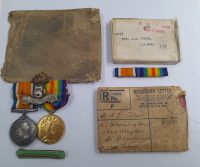Description
A Great War Royal Dublin Fusiliers Casualty pair awarded to Private Alfred Ernest Teese, 10th Battalion Royal Dublin Fusiliers Attached 19th Entrenching Battalion who was wounded by a Gun Shot Wound to his Left Foot in the Spring Offensive of 1918 comprising. 1914-1920 British War and Victory Medals, (40753 Pte. A. E. Teese. R. D. Fus.) contemporarily mounted for wear, toned fine.
The 10th Battalion Royal Dublin Fusiliers was disbanded France mid-Feb 1918, a month before Kaiserschlacht, men were dispersed to the 19th Entrenching Bn, no war diary exists, but an extract below 0n-line at dublin-fusiliers.com:
Entrenching battalions were mainly formed in February 1918 from the surplus of men left after the break-up of many infantry battalions . Their purpose was to hold reinforcements close to the front lines until units were out of the trenches and could receive them. The men in the Entrenching Battal
ons worked under direction of the Royal Engineers, usually repairing roads and improving defences. Men were all regarded as fit and ready to replace losses in fighting units at any time. The Entrenching Battalions all ceased to exist after May 1918.
1. The soldiers retained their own cap badges.
2. They were not necessarily posted back to battalions of their own regiments.
10th Battalion, the Royal Dublin Fusiliers had left 48 Brigade on 13 February 1918, and were officially disbanded two days later
10 Officers and 200 men went to 1st Battalion RDF
10 Officers and 200 men went to 2nd Battalion RDF
Balance 450 men went to 19th Entrenching battalion
200 men from 7th Leinsters also went to 19th Entrenching Battalion
The 19th Entrenching Battalion was located at St Christ, south of Peronne, where it assisted Canadien railway engineers to construct railway links to the front. The 19th Entrenching Battalion then fought during the Operation Michael Attack in March 1918.
21st March 1918
On the afternoon of 21st March the 19th Entrenching Battalion were moved by lorry along the congested roads from St Christ to Vraignes-en-Vermandois.
22nd March 1918
Having got to Vraignes-en-Vermandois, they were moved east to Vermand, reaching it at 1am and they took up a defensive position in front of the village. In the afternoon large numbers of Germans advanced, and the defenders inflicted heavy losses on the Germans. However the Germans decided to bypass the village, and at this point half the Battalion was withdrawn and the other half assigned to 24 Division. The battalion came under fire on the Vermand to Brie road during the day.
The Official History, France & Belgium 1918 has them marching to Vermand, where the battalion arrived at 1.45pm on 22nd. I think this should read 1.45am within the context of the retreat.
11th Hussars, 13/Middlesex (73rd Brigade) and 19th Entrenching Battalion covered the retirement. They fought a continuous rear-guard action, but the last parties did not leave their position until about 2pm., after the engineers had blown up three bridges over the Omignon … “
23 March
19th Entrenching Battalion moved to Devise and arrived to dig in at 10am. Retreating British troops passed through their line, and eventually the Germans arrived, across open country, and preceded by machine gunners. The Germans found a gap in the line left by retreating British troops, and as they risked being surrounded the 19th Entrenching Battalion withdrew to St Christ, and on back to Pressoir
The Official History, France & Belgium 1918 ” … Although the ground to be crossed was bare and flat, and the rear-guard battalions suffered from machine-gun and field-gun fire, all the troops passed through the Molignaux-Devise line, half-way to the river, by midday, and then three battalions attached to the 72nd Bde holding it as a rear-guard were ordered to withdraw. These units were the 24th Divisional Depot Battalion, the 19th Entrenching Battalion and 2 of the 3 companies of the 12/Sherwood Foresters (Pioneers). 1 They were only just in time ; for the enemy, working round the open right flank, reached the Somme south of Pargny almost as soon as they did and opened fire on them, although the Cavalry Brigade and two companies of the 1/Worcestershire (8th Division) had advanced across the river to Falvy to cover the withdrawal. … ” .
RDF Capt Robert Boyd was in charge of C Company 19th Entrenching Battalion, which was by now at Hattencourt. He was the only captain in the line here and was in charge of 4 companies, who were ordered to dig in 50 yards east of the town at 2am. They had just finished digging in when the Germans attacked at 6.30am.
Capt Boyd was ordered to hold the line at all costs, but at 7.15am was ordered to withdraw and join 16th (Irish) Division. 2 of his 4 companies had got away when Capt Boyd was knocked unconscious by shrapnel and taken prisoner.
27th March 1918
At 9am the 19th Entrenching Battalion counter-attacked and took back the village of Rouvroy-en-Santerre. But the Germans counter-attacked them and forced them back into old trenches just outside the village, with heavy casualties. There encountered a lot of enemy patrols during the night, and they also had the misfortune to be shelled by British artillery after dark.
28 March 1918
No information available
On 3 April 1918 19 Entrenching Battalion was ordered to pass its men to the 24th Division. The CO objected, stating that they would prefer an Irish Division. Hence it was absorbed by 16th Division, which it joined 4 April 1918.
Records show 3 men of 10th Battalion RDF were killed in action on 4th April
19th Entrenching Battalion disbanded 5 May 1918. Its troops went to 2nd Royal Munster Fusiliers
Private Teese appears in the Casualty List of the 15th of May 1918, he is shown from then on as a Dublin Fusilier, presumably he was wounded and removed from the Battlefield before the 19th Entrenching Battalion was disbanded. He had joined the Army on the 26th of August 1916 and was invalided out with Silver War Badge No. B154147 on the 7th of March 1919.
Sold with original white cardboard box and envelope addressed to Mr A.E. Teese No1 Washington Street, Accrington, N. Blackburn Lancs. Original Medal Ribband Bar, Original Wound Stripe with backing plate and pin, original Royal Dublin Fusiliers Cap Badge turned into a sweet-heart brooch. Two envelopes addressed to the same address post marked 1942
Copy Medal Index Card confirming the Pair and award of the Siver War Badge. Copy Medal Roll, Copy Pension Card confirming GSW L. Foot. Copy SWB roll Copy Casualty List dated 15th May 1918.


